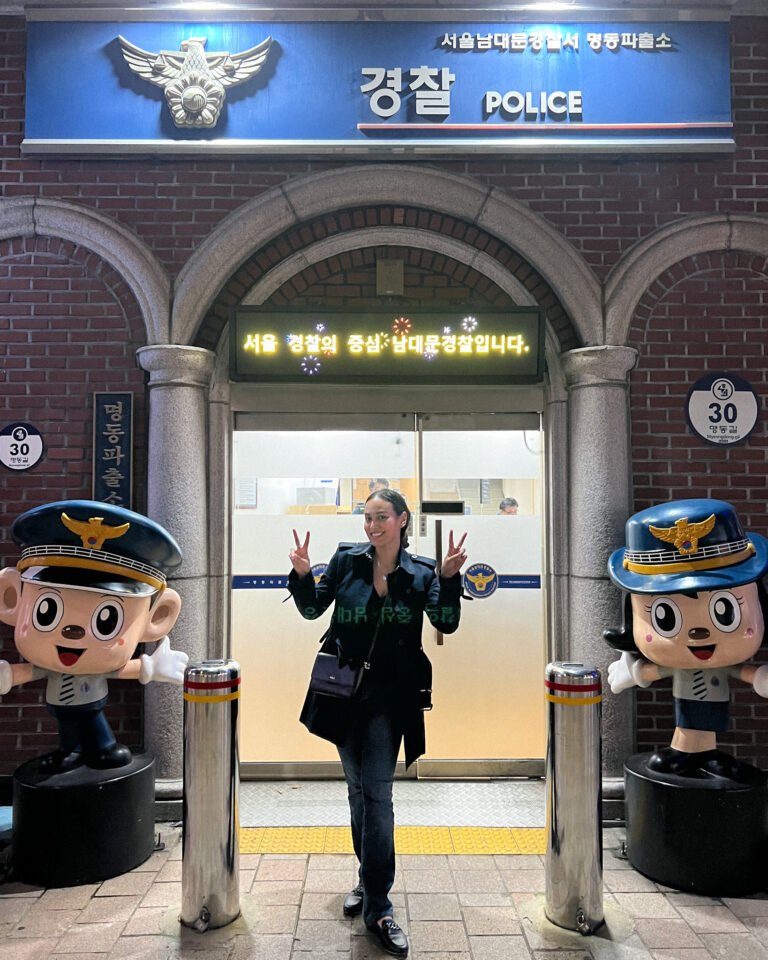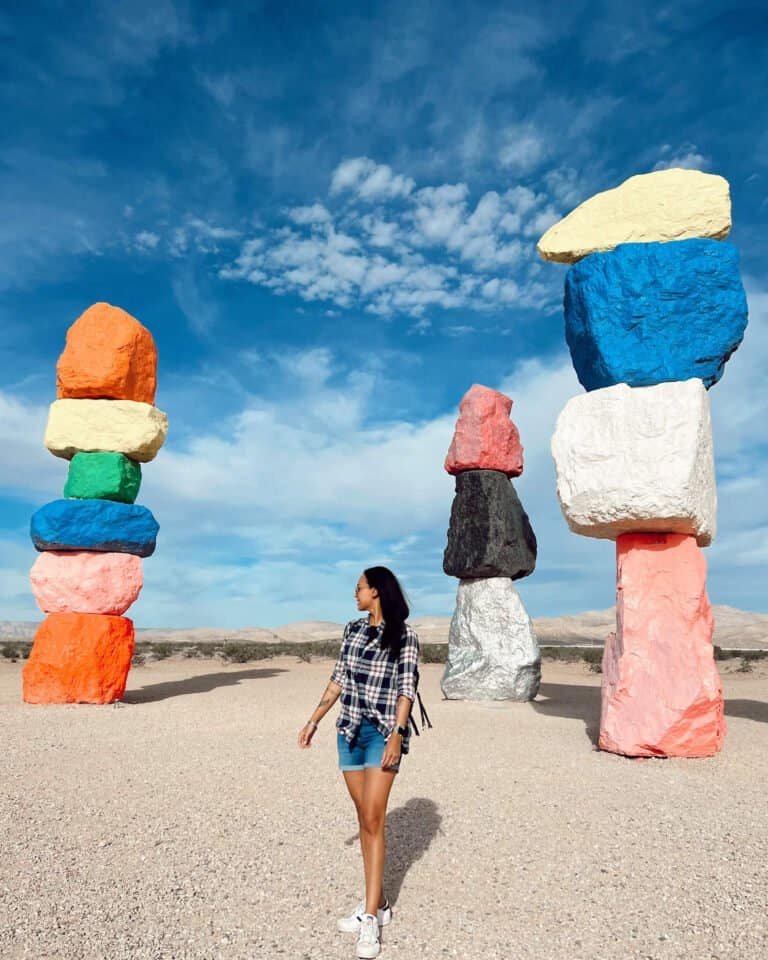The Ultimate 2-Day Itinerary To Kyoto For First-Time Travellers
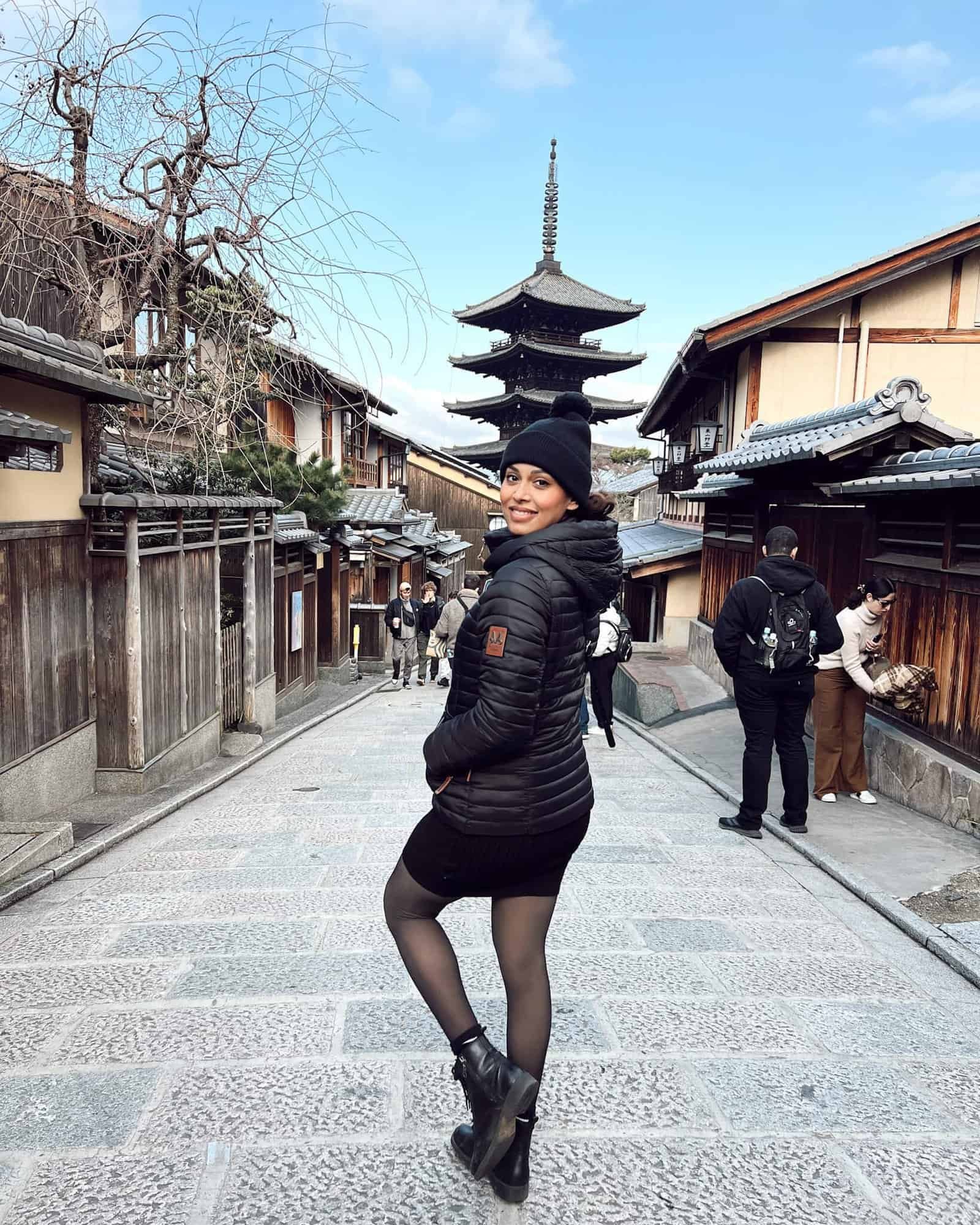
This post may contain affiliate links. That means if you click and make a purchase, I may earn a small commission at no extra cost to you. I appreciate your support!💙
Planning a trip to Kyoto? This is the perfect 2-day itinerary to Kyoto! Kyoto is one of the many cities you must visit when planning a trip to Japan. It is the opposite of Tokyo, and you will love the traditional vibe of Kyoto.
I loved Kyoto! Kyoto is fantastic, from traditional Japanese temples and shrines to geisha to amazing food! Be prepared to wake up early, and expect Kyoto to be busy! Check out the crowd congestion forecast in Kyoto from Kyoto City Tourism before planning your trip.
The authentic vibe in Kyoto is amazing, but it’s also very crowded and touristy. Especially during summer, fall and cherry blossom season. However, I still loved Kyoto and stayed longer on my first trip there.
I tried to avoid the crowds by waking up early every day. That way, you’ll have most tourist sights to yourself. It does require some planning and maybe an Uber to speed up travel times
Don’t forget to check out my ultimate solo female travel guide to Kyoto and steal my 2-week itinerary to Japan!
- ⛑️ Do NOT travel without travel insurance: Check out Safety Wing for reliable travel insurance.
- 🏨 Stay in Seikoro Ryokan or Henn Na Hotel.
- 🫖 Book a traditional tea ceremony in a tea house.
- ✈️ Book your ticket to Kyoto with Skyscanner.
- 🎰 Find the best tours and excursions to Kyoto with the flexible Get Your Guide.
- 🎫 Book your train tickets for Kyoto easy online via Klook.
- 🚲 Book a guided full-day bike tour that covers most highlights in Kyoto.
Your 2-day itinerary to Kyoto overview
- Day 1: itinerary Kyoto: Fushimi Inari & Arashiyama Bamboo Forest
- Day 2: itinerary Kyoto: Kiyomizu-dera Temple & Gion
Is 2 days in Kyoto enough?
Kyoto is not as big as Tokyo or Osaka, but there is a lot to see and, of course, to eat. If you’re pressed for time, I recommend spending at least two full days in Kyoto. This means staying two nights so you can get the most out of both days and start your day early.
The best option, I think, is to stay for at least three full days for a more relaxed pace. I originally planned three days in Kyoto on my first visit, but I extended my stay by two more days because I loved it so much.
Can you visit Kyoto on a day trip from Osaka?
Yes, definitely! Kyoto is only a 20-minute train ride from Osaka. Many tour buses also travel from Osaka to Kyoto, arriving around 10 a.m. You can easily take the earliest train and get back to Osaka in the evening.
But I recommend staying in Kyoto over Osaka. Kyoto has a more authentic vibe, and you can get to most sights around sunrise if you stay in Kyoto to avoid the crowds.
How to get to Kyoto
You’ll probably visit Kyoto from Osaka or Tokyo. I recommend taking the bullet train, which is a great and comfortable experience. Train tickets are not cheap, but I find it easy and hassle-free.
The Shinkansen bullet train is the fastest way from Tokyo to Kyoto, in just 2,5 hours. You can buy a train ticket at every train station through the ticket machines (purchase a few days before departure to make sure you have a good seat) or buy Kyoto train tickets online via Klook.
The website is in English, so it may be a little easier to understand. I have a great blog post on public transport in Japan that also covers the train.
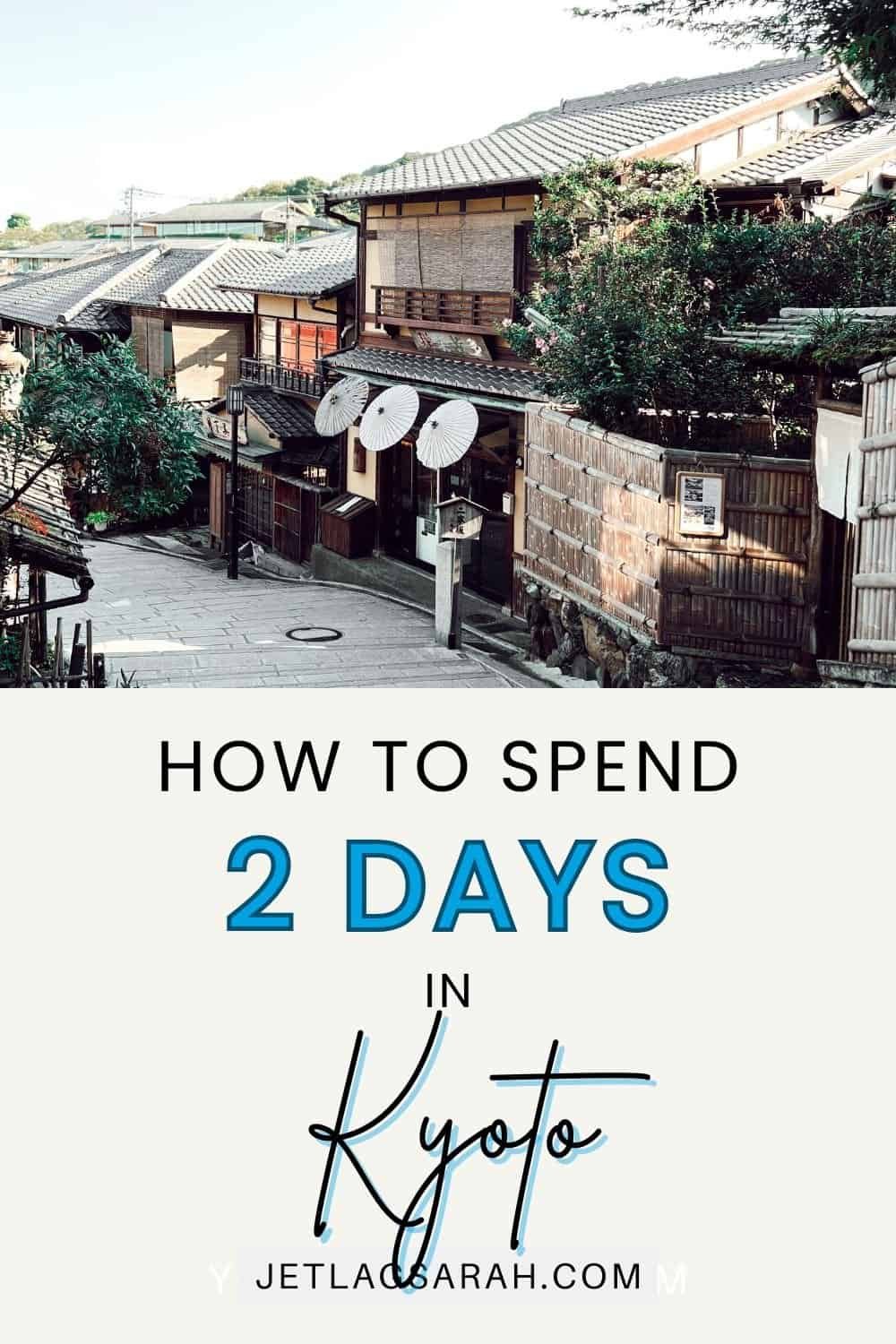
What is the best time to visit Kyoto?
The most popular times to visit are in the fall for the fall foliage and from mid-March to May for cherry blossom season, but more on that later! I visited Japan in September and March.
Winter in Kyoto
I loved visiting Kyoto in mid-March, maybe I was still in my winter era, so I didn’t mind the colder weather. With the weather chillier, sightseeing and walking were much more doable than walking around in 30 degrees Celsius (95 degrees Fahrenheit).
Do check the weather before leaving, because in my situation, the weather ended up being much colder than expected. Winters in general are very cold in Japan.
Summer in Kyoto
Summer in Japan can be very hot. If that’s your thing, go for it. However, the older I get, the less I want to be doing a lot of activities when it’s brutally hot. I love hiking, I even go hiking alone as a woman, but I hate it when it’s too hot outside.
If you want warm weather in Japan, I recommend visiting in September. In September, the weather was great! Chilly in the morning, but nice and warm when the sun comes up!
I was walking around with shorts, dresses and sandals most of the time. Even the evenings in Tokyo around that time were very pleasant. You don’t need a jacket, and there was no rain.
The cherry blossom or fall foliage season in Kyoto
I highly recommend planning your trip to Kyoto during cherry blossom season or in the fall if you can. These are two of the most magical times to visit, and for good reason. In spring, the country transforms with soft pink and white sakura flowers in full bloom, while fall brings vibrant foliage in stunning shades of red, orange, and gold.
Both seasons are breathtaking, but remember they’re also popular, so expect higher prices and bigger crowds. Still, trust me, it’s 100% worth it for the unforgettable views and atmosphere.
When I visited at the end of March 2024, I was just a little too early for cherry blossom season (there were only a few in bloom), as colder-than-usual weather had delayed the blooms. Timing is everything in Japan!
What budget do I need for Kyoto?
Kyoto (and Japan in general) is not as expensive as it it’s made to be. Especially since the Japanese YEN has been low, that means more YEN for your bucks. I was surprised by how affordable Japan is. And of course, you can go nuts and stay in high-end hotels and eat every omakase dinner at high-end restaurants.
You could spend 10 grand easily if you want to. But if you’re more of a bougee on a budget type of traveller, like myself, you’re going to do fine with all the budget to mid-range accommodation.
I like to call it “everything in balance”. I splurge on the things I care about, and that affects my safety. I’d say expect to pay around $100 to $200 for budget to mid-range hotels. For meals, you’ll find affordable options in many izakaya, yakitori or gyoza places for an average of $30. Any fancy omakase or sushi restaurants will cost you around $100.
Drinking wine, cocktails, and mixers will dig into your budget, say $10 per glass. To stay within budget, you can always grab a simple convenience store snack like onigiri, sushi and an egg sandwich.
Most tourist sights are free, and tours or workshops can vary from $50 to $100.
- 14 Surprising Things to Know Before Travelling To Japan: Respect The Culture Like A Pro
- The Ultimate 2-Day Highlights Itinerary To Traditional Kyoto
- Don’t Miss These Fantastic Boutique Hotels in Kyoto for A Unique Trip
- 9 Expert Reasons Why Japan is Fantastic for Solo Female Travel
- The Best 6 Top-Rated Food Tours in Osaka: Taste Japanese Cuisine
- Discover The Best Tours To Mount Fuji In Japan For An Epic View
- How To Use Public Transport In Japan: Do Not Get Lost
- The perfect one-day itinerary to Kyoto
- The Ultimate 2-Week Solo Itinerary: First Time in Japan
- The Ultimate Solo Female Travel Guide To Kyoto
- The Perfect 5-day Itinerary to Tokyo: The Highlights
- 3 days in Tokyo: see, eat and explore it all
Where to stay for your 2-day itinerary to Kyoto?
Kyoto is a city where you’ll be walking a lot! Even though the city has great public transport, it’s not as extensive as Tokyo’s. Some areas, especially the areas with traditional tourist sites, are still at least a 15-minute walk from the nearest subway station.
I feel there are a few areas within Kyoto that are perfect for a stay! These locations are based on convenience and vibe. The best areas to stay in would be near the Gion-Shijo station, that is, Southern Higashiyama, Kyoto station and downtown Kyoto.
I always choose hotels that are safe and preferably something unique, like a beautiful design hotel. However, price is also important, especially if you’re travelling solo! I tried my best to give you a perfect mix of both.
Southern Higashiyama Kyoto
If you’re staying near Gion-Shijo station, you’re smack in the middle of all the tourist sights! You can easily do a lot on foot, like Kiyomizu-dera, Sannenzaka, and Gion. Expect Higashiyama to cost you more than average.
This is the traditional Kyoto you’re looking for, and lots of travellers prefer to be in this location. You’re still going to be walking a lot, but it’s perfect if you love walking and want to stay near most tourist sights with an authentic traditional atmosphere.
Ryokan Seikoro
If anything, I would avoid the summer; it’s just too hot and too crowded. I visited Kyoto in mid-September, which was great! The weather was just perfect. It’s warm enough for summer attire and no jacket in the evenings.
The beautiful Ryokan Seikoro is within walking distance of Kiyomizu-dera, downtown Kyoto and Gion. To soak up the Kyoto vibe, treat yourself to a stay at a traditional Japanese ryokan. Seikoro Ryokan is a top pick! Past travellers rave about it, and it’s in a prime spot with the subway just around the corner.
Staying at Ryokan Seikoro is going to take a hit on your budget, but it’s worth the exceptional service and stay! It also books up fast, so make sure to reserve early!
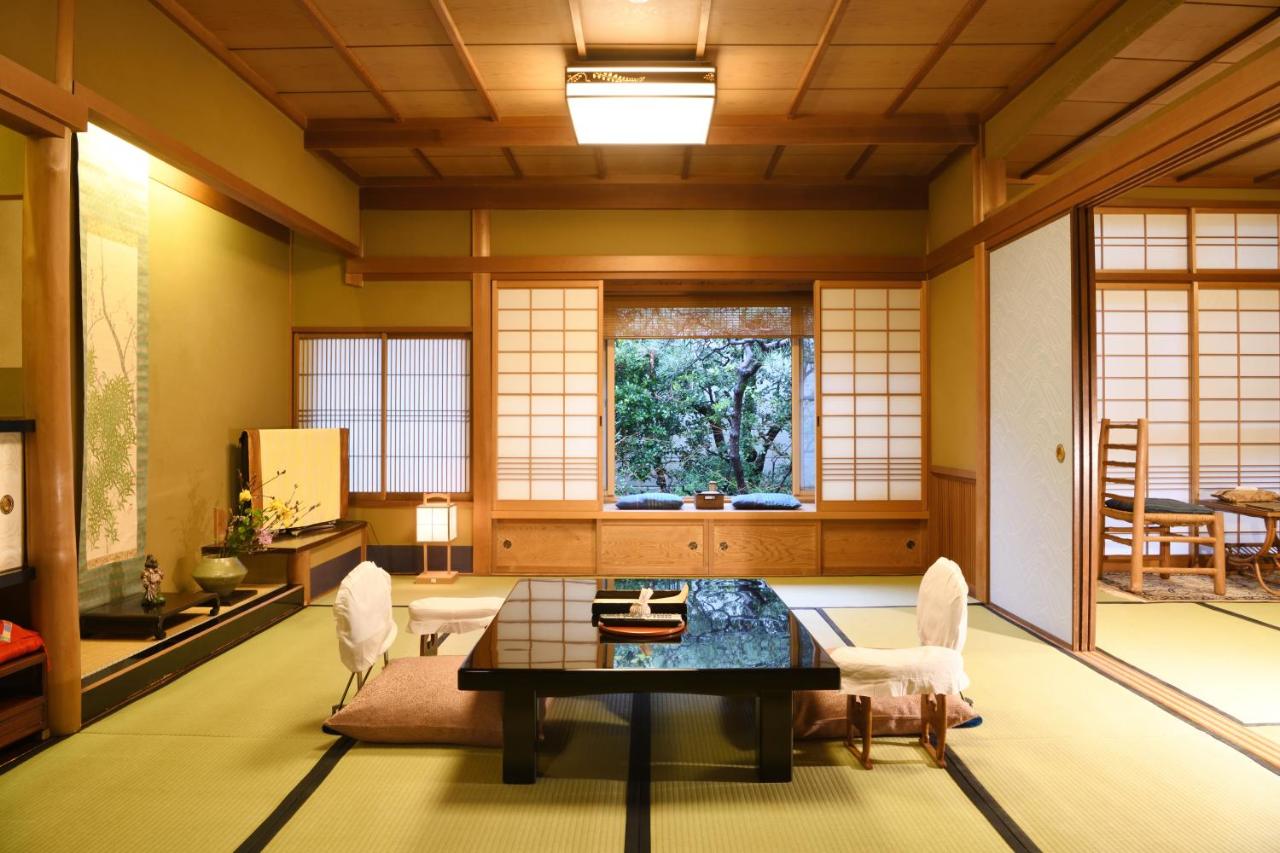
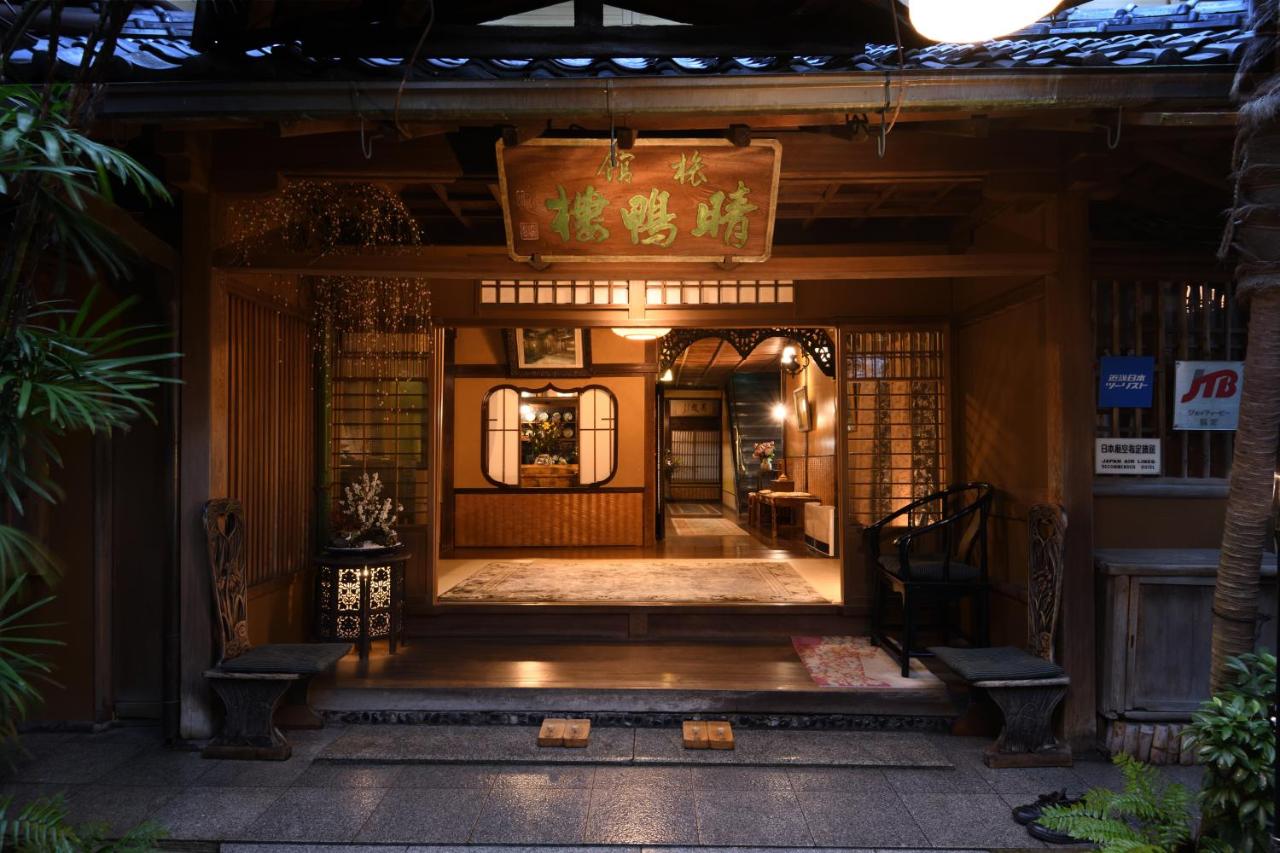
The Celestine
The Celestine Kyoto is a gem—beautiful, modern, and in the perfect location. It’s just a 15-minute walk to Kiyomizu-dera Temple and 10 minutes from Gion-Shijo subway station.
You’ll be right in the heart of Kyoto, surrounded by restaurants, bars, and shops—everything you need is at your doorstep.
And the vibe? Total bliss. The calm, serene decor makes it the ultimate spot to relax and recharge after a day of exploring the city. This place will seriously impress you.


Kyoto Station
Kyoto Station is another great spot since you’re close to every line that connects everywhere in Kyoto and connects Kyoto to the rest of Japan. This is where I stayed both times when visiting Japan.
I loved that I could connect to every line within Kyoto conveniently from Kyoto Station and take the train to other cities like Osaka and Nara. If you’re using Kyoto as a base to take a few day trips, staying near Kyoto Station is going to be helpful.
Henn Na Premier Hotel
Check out Henn Na Premier Hotel in Kyoto, which is not far from Kyoto Station and a 5-minute walk from the nearest subway station. I loved the easy access to Kyoto Station, the beautiful rooms and the affordable price!
Henn Na Premier Hotel is right on the border of Kyoto Station and Downtown Kyoto.
I stayed at the Henn Na Premier Hotel in April 2024, and since then, the hotel has rebranded and upgraded! I loved the rooms that fully give off a traditional minimalist Japanese and peaceful vibe. The rooms are on the smaller side, but perfectly good for two people.
The hotel has all the amenities you can think of, like most hotels in Japan.
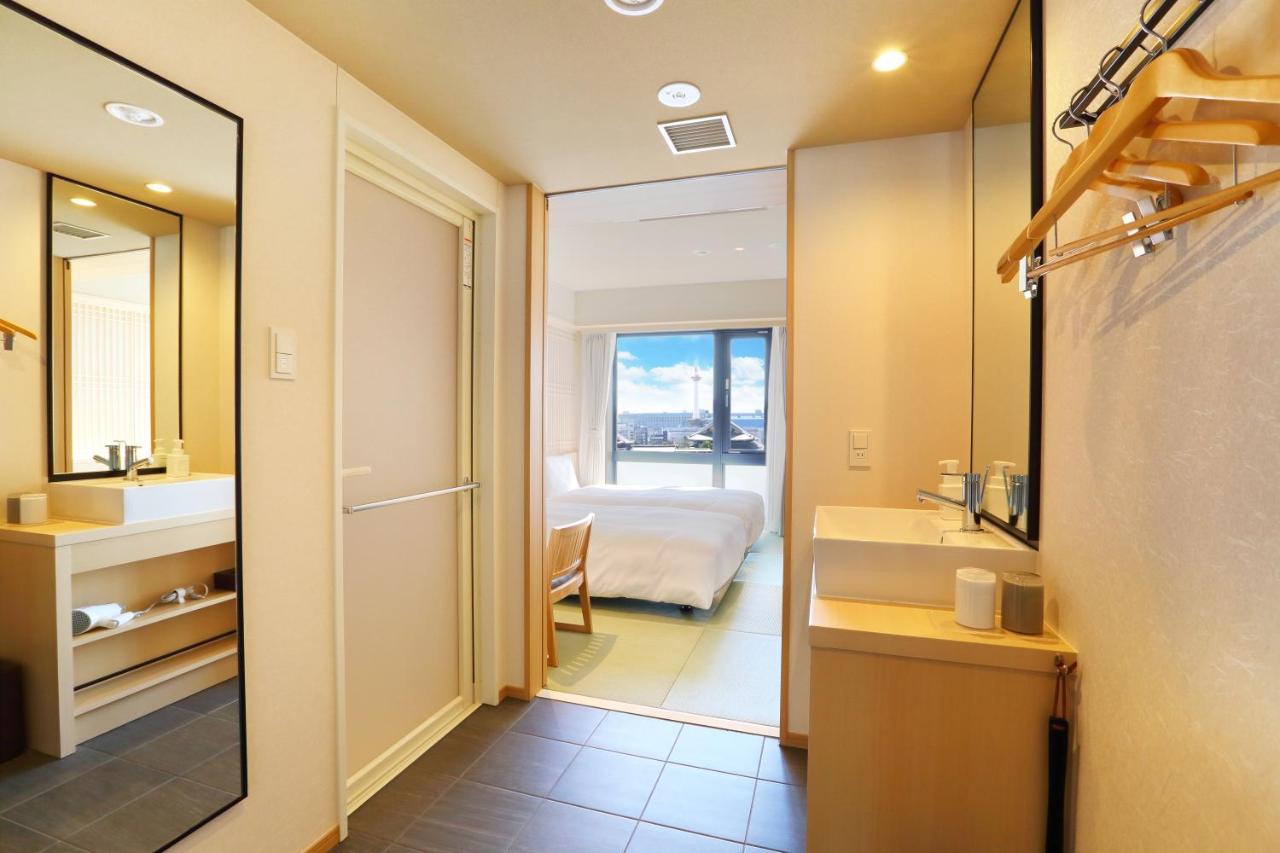
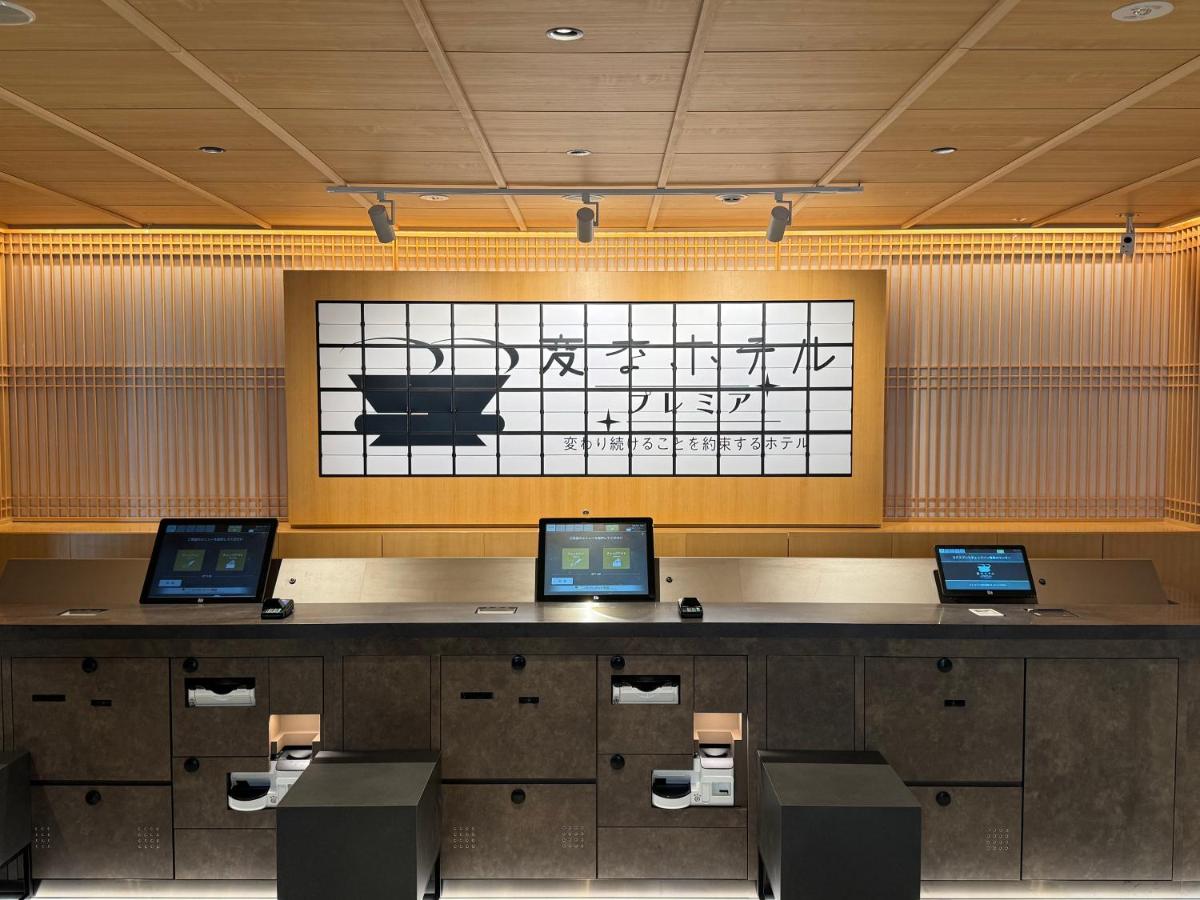
Downtown Kyoto
I love downtown Kyoto! This area is vibrant and great if you love to do some shopping as well! There are plenty of shops in this area, and you’re close to Pontocho Alley (great for restaurants in the evening).
I found this area to be easily accessible by subway, and you can walk around endlessly checking out amazing shops. I walked around for hours doing my souvenir shopping, and for lunch, Nishiki Market is just around the corner!
Hotel Forza Shijo
Check out Hotel Forza Shijo, which is a great option for solo travellers! The hotel is affordable, the rooms are great, and the location in downtown Kyoto is perfect. The hotel is only a 7-minute walk from Gion Shijo Station.
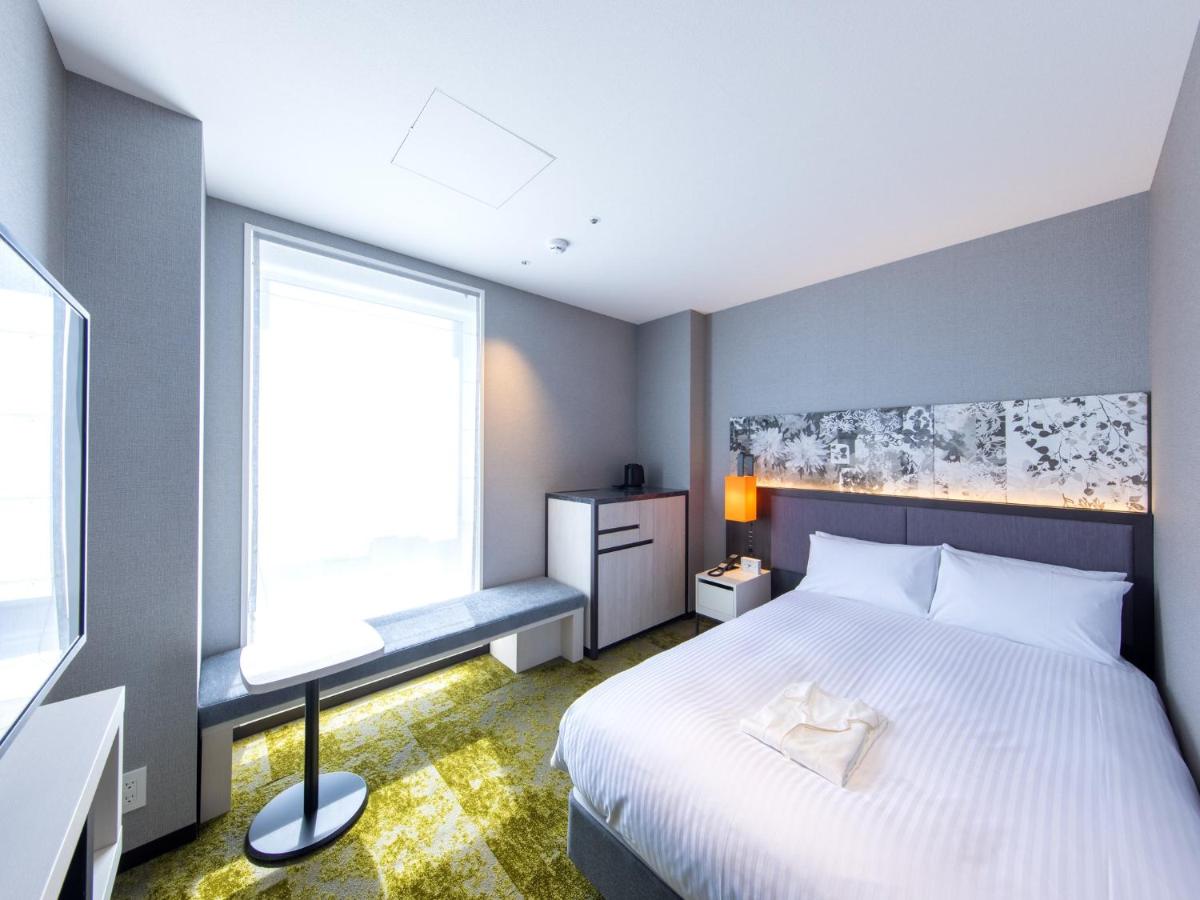
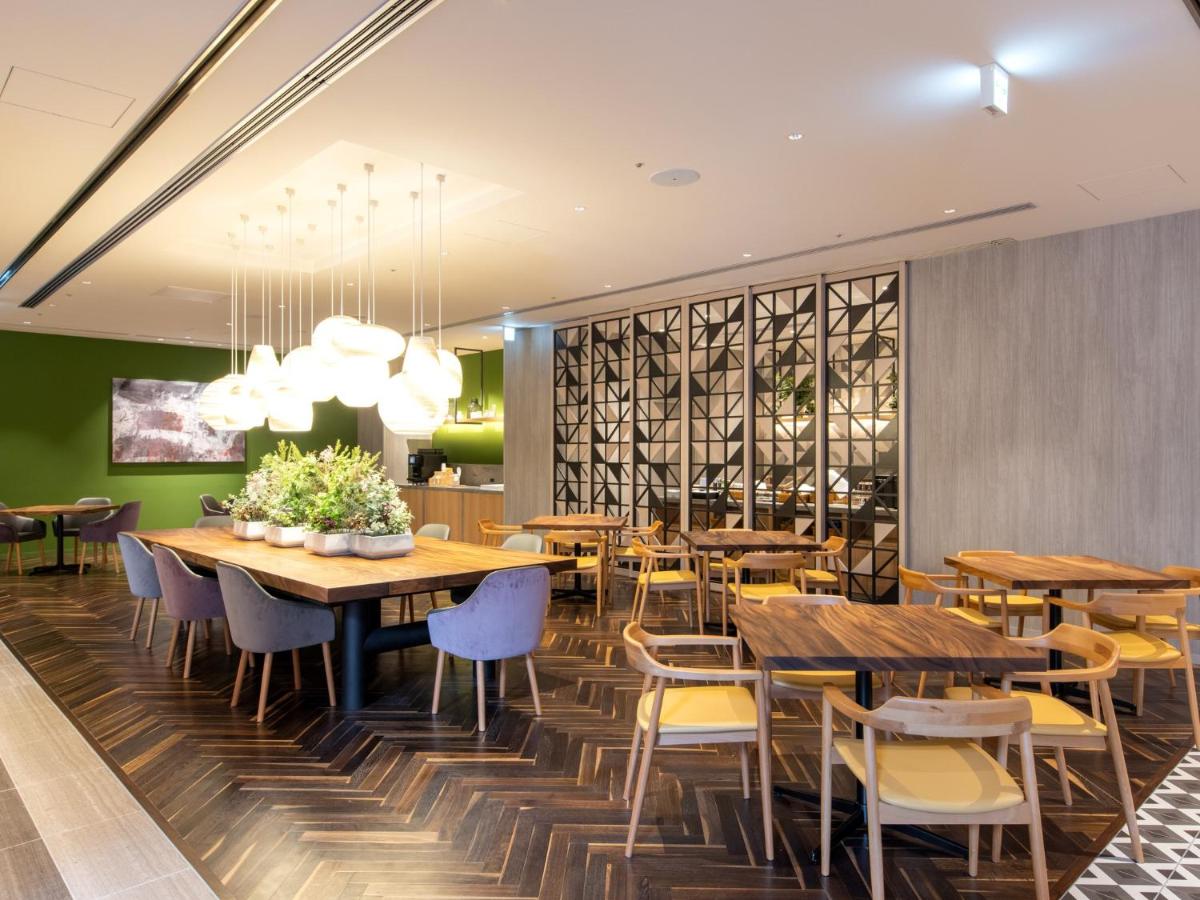
Ace hotel
Another beautiful option is the stunning design hotel Ace! Ace Hotel Kyoto is an absolute gem in the heart of Kyoto! They offer free bikes (you’ll love them in Kyoto!), a fitness centre, a lovely garden, and a terrace to relax on. The interior design is what I love the most about the Ace Hotel!
It’s got that modern Japanese vibe with quirky art and playful decor—think industrial meets romantic in the coolest way. The rooms are fab: air-conditioned with a comfy little seating area to chill. Breakfast is a total win, whether you’re into à la carte, continental, or a classic American plate. And not gonna lie… the coffee bar on-site? So good.


>> Are you more of a design boutique hotel traveller? Check out more of these fantastic boutique hotels in Kyoto for a unique stay in Kyoto!
The best things to do on your 2-day itinerary to Kyoto
Fushimi Inari
Fushimi Inari is hands-down one of the most iconic spots in Japan. It was the very first place I ever saw online that made me want to visit Japan, and it lived up to the hype!
This shrine is known for its endless rows of red torii gates (yes, those gates you’ve seen all over Instagram). It’s super easy to get to by subway, and from the station, it’s just a short walk to the entrance.
If you want those quiet, dreamy shots without the crowds, come early — like really early. Aim for sunrise or at least by 06:30. The further you walk through the gates, the fewer people you’ll see.
You can hike to the summit. It’s a peaceful walk with even more torii gates and fox statues (kitsune) along the way.
Gion
Gion is Kyoto’s famous geisha district, and it’s got that magical, old-world feel. Come here in the late afternoon or evening to see the area glow, and you might even catch a glimpse of a geisha in full kimono.
The main street to explore is Hanami-koji Lane. Be mindful while exploring; it’s a residential area, so avoid wandering into private streets. And please don’t photograph geisha without asking. Let’s all be respectful guests.
Kiyomizu-dera Temple
Kiyomizu-dera is another must-see in Kyoto and pairs perfectly with Hokan-ji Temple and the charming streets of Sannenzaka and Ninenzaka. I’d recommend visiting all of them in one go.
Tour buses start arriving around 10:00, so plan to get there earlier if you want to wander without the crowds.
The temple grounds are big, and there’s loads to see — including some epic dragon statues. I’ve heard the view at sunset is stunning, but I sadly missed it. If you can, stick around for golden hour!
Hōkan-ji Temple (Yasaka Pagoda)
This five-story pagoda is one of Kyoto’s most iconic silhouettes — you’ve seen it pop up on your feed. Hōkan-ji, or Yasaka Pagoda, is tucked away in the Higashiyama district, just a 15-minute walk from Kiyomizu-dera.
It dates back to the 6th century and gives off major peaceful, timeless energy. It’s especially stunning during cherry blossom season or at sunset. Heads up! You might have to wait your turn for that perfect shot because it’s that photogenic.
Sannenzaka & Ninenzaka
Wandering through Sannenzaka and Ninenzaka feels like stepping into a scene from old-school Japan. The streets are full of charm, think cobblestones, wooden facades, and cute little shops. By mid-morning, it’s packed with people, but if you go early, you can catch the calm and get those dreamy shots you’ve probably seen all over Instagram.
There are plenty of places to grab a bite or a matcha latte along the way. Oh, and there’s a traditional-style Starbucks that opens at 8:00, but there’s always a queue, so go early if you’re curious.
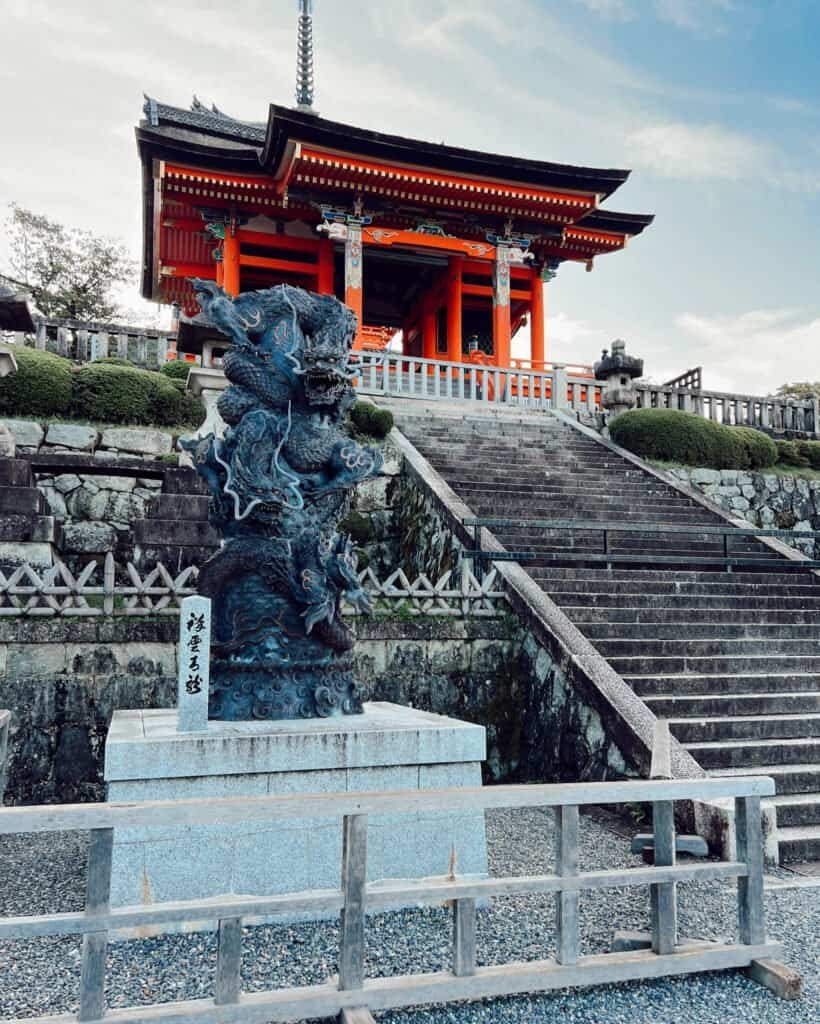
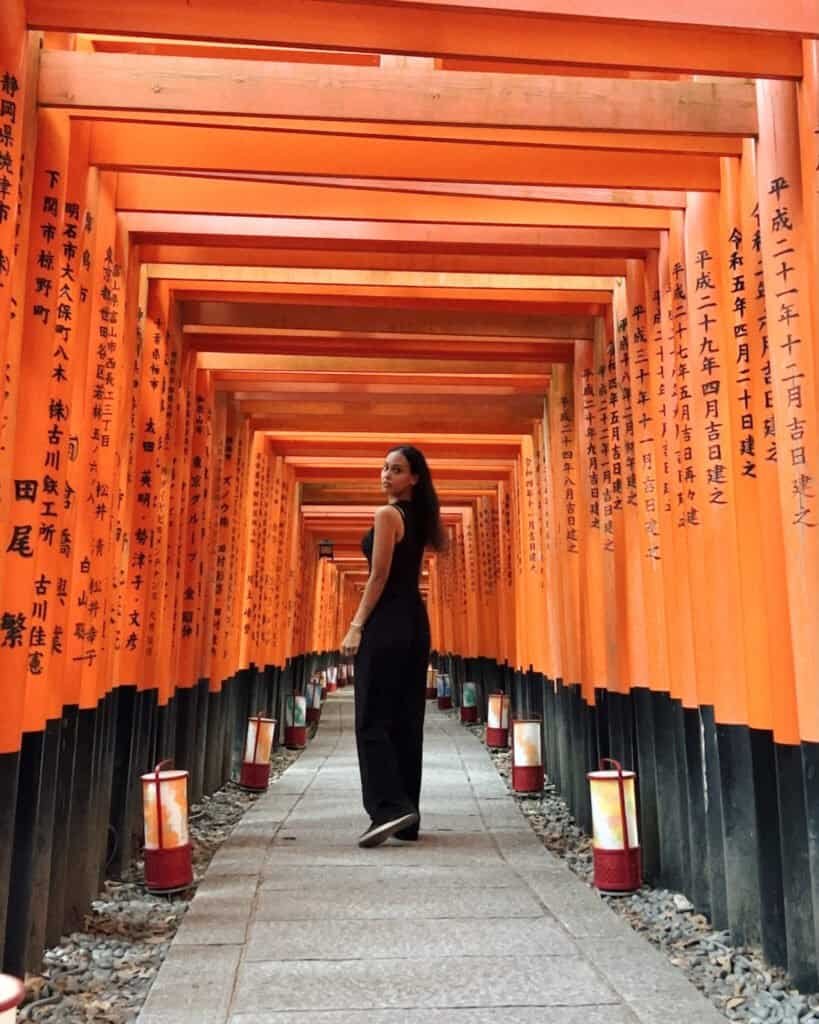
Arashiyama Bamboo Forest
This one’s a classic for a reason. Located about 30 minutes from central Kyoto by train, the Arashiyama Bamboo Grove is peaceful early in the day and worth the trip.
The main bamboo path isn’t huge, but it’s still a magical place to walk through. You’ll also find beautiful gardens and small temples nearby if you feel like exploring more of the area.
Arashiyama Bamboo forest can get very crowded. I arrived around 7 AM in the morning and it was perfect. Around 9 AM, it started to get busier, and I can’t even imagine how busy it would be around noon.
Walk further up for hopefully a quieter spot, and the area around is nice for a walk.
Kinkaku-ji (Golden Pavilion)
This temple stands out from the rest with its shimmering golden exterior, it’s seriously something else. Kinkaku-ji, also known as the Golden Pavilion, is a stunning Zen Buddhist temple in Kyoto that’s completely covered in gold leaf.
It sits beautifully by a pond, creating a perfect reflection that looks like something out of a fairytale. Originally built as a shogun’s villa, it became a temple in 1408. Between the peaceful gardens and its glowing architecture, it’s no wonder this spot is one of Kyoto’s most iconic sights.
Nishiki Market
Nishiki Market is a fantastic food market in Kyoto where you can try so many delicious things. Especially during lunchtime, it can get extremely busy, so come prepared.
Nishiki Market is a kind of food market hall where you can get ‘street food’ or eat in one of the many small restaurants. You’ll find anything from sushi to oysters to grilled meat skewers and sake.
If you want to try the famous Wagyu and Kobe beef, but don’t want to spend too much, this is the place. You’ll find stalls with meat skewers, so you can try them without breaking the bank. I loved it and liked the wagyu beef better!
Nishiki Market is very touristy, but still a great place to try out many delicious Japanese dishes. Places in Nishiki Market that I went to are 2D Tearoom BAW, Steak and Wine and Daiyasu.
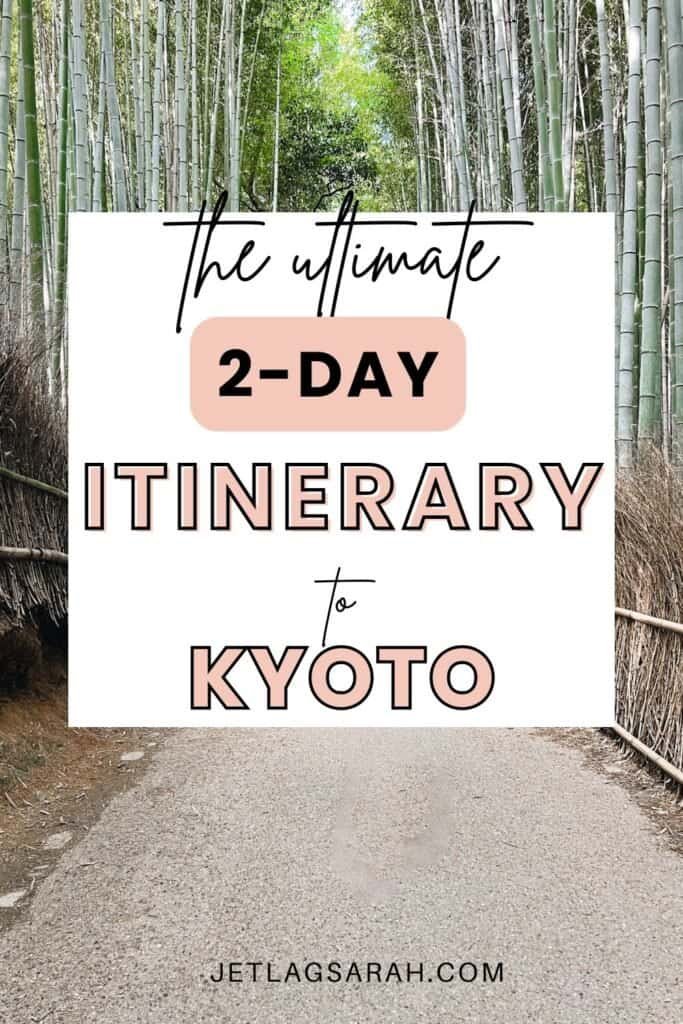
2-day itinerary to Kyoto
Day 1: Fushimi Inari and Arashiyama Bamboo Forest
Start your day early, I suggest 7 AM, and make your way to Fushimi Inari. Fushimi Inari is a famous temple with many red torii gates. It’s an iconic sight! Fushimi Inari can get extremely crowded, so the best thing is to wake up early and be there right after sunrise.
You could hike up to the summit or walk as far up into the red tori gates until it gets less crowded. Be prepared, it will get crowded, especially after 10 AM when the tour buses start rolling in.
After Fushimi Inari, make your way to Tōfuku-ji Temple. After Tofuku Temple, grab lunch at Wagyu Sushi Roll, a great place famous for its wagyu beef sushi.
Visit Arashiyama Bamboo Forest in the afternoon. It will be crowded, but you can find some quieter spots to take photos. The area itself is a nice stroll, and there are a few temples.
From Arashiyama Bamboo Forest, make your way to the Kinkaku-ji temple. This temple is famous for its golden exterior. It is at its best with the sun shining on it, so try to get there when the sun is out.
Make your way to Kyoto Shinkyogoku Shopping Street, start north, and walk your way down to the Kyoto Kawaramachi area. You’ll find many stores and restaurants. Get your souvenirs here for the people at home.
For dinner, I highly recommend Kyoto Engine Ramen! This place has the best ramen in Kyoto, and they have gluten-free and vegan options, too!

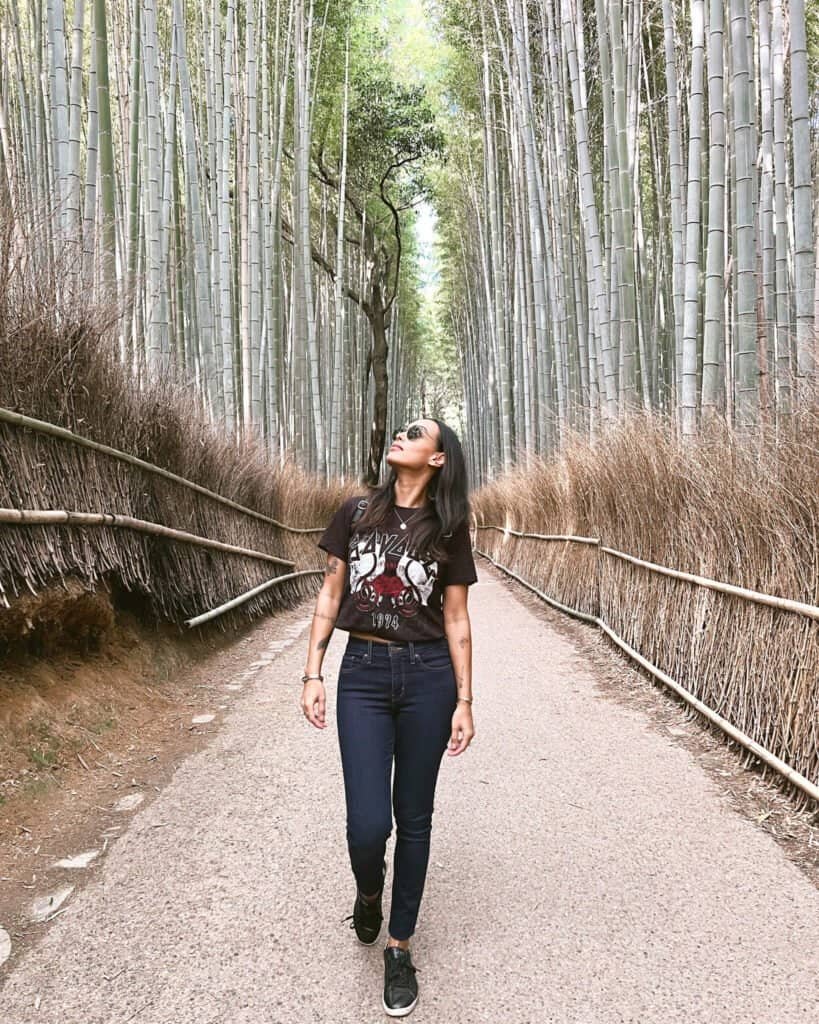
Day 2: Kiyomizu-dera Temple and Gion
Start your day early again and go to Hokan-ji Temple. This famous temple is also iconic for a few good shots from the street angle with the Hokan-ji temple in the background.
From Hokan-ji, walk to Kiyomizu-dera Temple. This area is quite big and can still get crowded. There are plenty of places to take great photos, and you don’t have to walk all the way up. The area is free to visit, but to enter the temple, you’ll have to pay an entrance fee.
Sannenzaka and Ninenzaka are both beautiful areas near Kiyomizu-dera where you can walk around, even though the streets can get extremely crowded. There’s a Starbucks with a traditional interior where you can stop for an iced chai latte if you want to wait in a long line.
Since you’re in the area, check out a traditional tea ceremony in Kyoto, a fantastic experience to take home with you!
After Sannenzaka, make your way to Nishiki Market! Nishiki Market and the streets around Nishiki Market are fantastic for lunch! You can get anything from sushi to wagyu skewers to roasted chestnuts. It has this street food vibe, which I love!
Save some room for dessert and visit the 3D BAW Tearoom for a chocolate croffle with ice cream. It’s delicious!
The best time to visit the Gion District is at the end of the afternoon or the beginning of the evening. You can walk around Gion and maybe even spot a geisha. Be respectful of the neighbourhood and the geisha, and don’t walk into the private streets!
If you can use some fortune and want to get rid of negative energy, don’t forget to visit Yasui Kompiragū Shrine. This shrine, located near Gion, is said to release negative energy and make your wishes come true.
For dinner, go to Pontocho or Restaurant Alley! You’ll find many restaurants and bars for a drink and dinner here or anywhere along the riverside. If you love gyoza, check out Chao Chao Sanjo Kiyamachi.
The best tours to book on your 2-day itinerary in Kyoto
Kyoto Bento Cooking Class
Bento boxes are a typical Japanese lunch meal. This Kyoto Bento Cooking class is just as fantastic as a bento box! Bento boxes are like the Avengers of Meals – carbs, protein, and a bunch of colourful veggies and fruits all in one squad.
During this cooking class, you will learn how to make your own bento box and get to enjoy it for lunch! A fun morning class in Kyoto that includes lunch.
The English-speaking chef will tell you about the Bento Box’s cultural background. It is a great and delicious experience to spend your morning in Kyoto.
Kyoto: Ramen Bowl Painting and Michelin Cooking Class
OMG, what an amazing idea for a unique experience in Kyoto! This workshop is fairly new in Kyoto, and I’m already loving it. You’ll get to paint your ramen bowl, learn how to make ramen, eat it, and you’ll get to keep the bowl.
How amazing is that?
Kyoto Highlights Bike Tour
I’ve said it before. Kyoto is a great city to explore on a bike. This Kyoto Highlights Bike Tour lasts a whole day and takes you to the most iconic highlights in Kyoto with a guide!
The tour takes about 8 hours and includes a small lunch. You’ll start your day in Arashiyama Bamboo Forest and make your way to Fushimi Inari, Kiyomizu-dera, Gion and Kinkaku-ji.
You’re tackling all the major sights in Kyoto! A great way to explore Kyoto.
Kyoto Tea Ceremony Ju-An at Jotokuji Temple
Take in the experience of the art of tea drinking in this traditional Japanese tea ceremony at Jotokuji Temple. The Tea Master will tell you all about its social significance in Japanese culture.
You can also rent a kimono to be fully immersed in the Kyoto Tea Ceremony Ju-An at Jotokuji Temple!
Kyoto Sake Brewery Tour with Food Pairing
Are you new to Sake? Or maybe you are a sake lover? Either way, visiting a sake brewery is a must when in Japan! This Kyoto Sake Brewery Tour with Food Pairing is the perfect way to learn more about the world of sake.
Get ready to savour sake like never before! You’re diving into uncharted sake territory, unveiling bottles that have never been exported. Your guide will spill the tea on the taste spectrum – from dry to fruity to sweet – and spill the secrets of how these flavours are crafted.
My favourite places to eat in Kyoto
If you love to try out as much food as possible, let’s be friends! Kyoto is a fantastic city with so many great restaurants. I am such a foodie, and I love to research amazing places to eat.
You’ll never see me walking into a tourist trap, I’ll always read reviews or ask for local recommendations. Some restaurants are worth the price tag if they’re an amazing omakase or fine dining restaurant. But honestly, you can find something for every budget.
Yakitori Otonari
I found this Yakitori Otonari place online after coming back from Kiyomizu-dera Temple in the afternoon on my first day in Kyoto. The place is very small and can only seat probably ten people.
I was by myself, just right around opening time, and I love the place. They have a lot of delicious different yakitori, sake and beers. I found the staff to be friendly, and the younger girl working there spoke a little English at the time.
Chao Chao Gyoza Sanjo Kiyamachi
Chao Chao Gyoza Sanjo has the best gyozas in Kyoto. I loved eating here and shared a few gyozas with another traveller I met the day before. The staff is amazing, very friendly, and the service is fast.
Expect there to be a line, especially during dinner time. I think we waited around 30 minutes to get in, but it’s worth it. If the queue is too long, you can also get takeout.
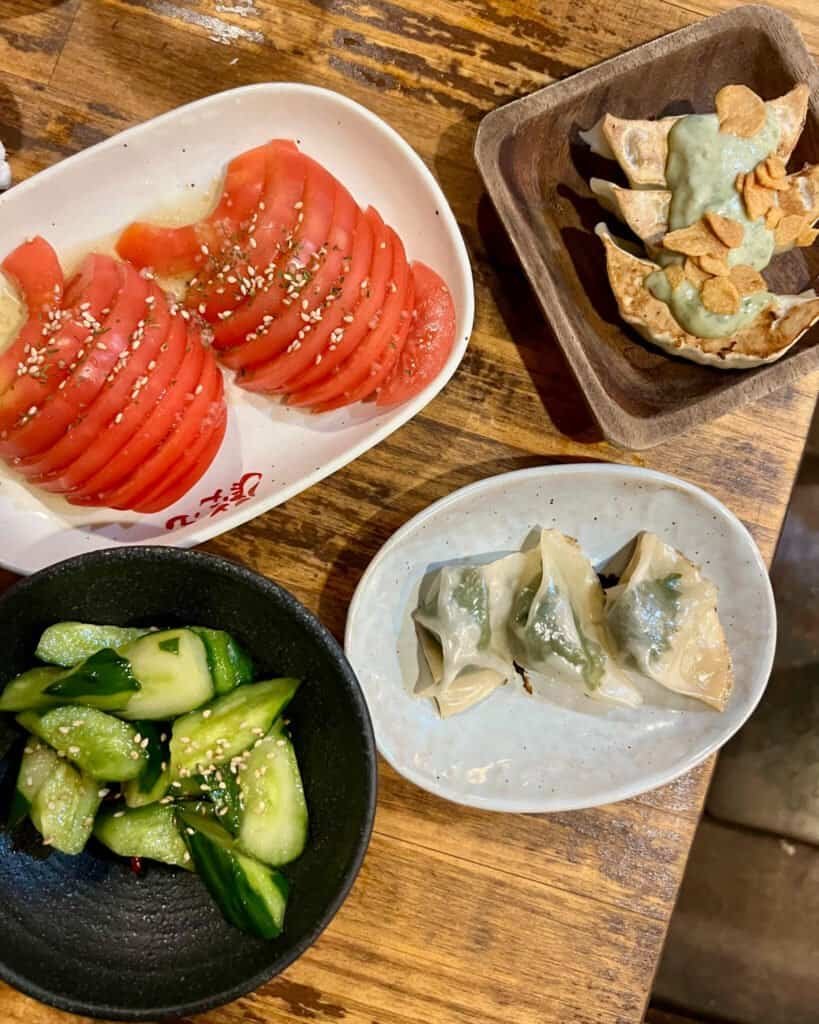
Kyoto Engine Ramen
Kyoto Engine Ramen was, according to their story, the first ramen place in Kyoto (maybe in Japan too) that serves gluten-free ramen. I’m not a gluten-free person, but if you are, this is the place to be! They also have a vegan ramen, which is very unique for Japan.
Besides that, their ramen is delicious! Nothing beats a big bowl of savoury and spicy ramen after a long day in the city. As with many restaurants, expect there to be a queue, but everything is organised pretty well. We waited for about 30 minutes and sat upstairs at the bar.
I think I ordered the Kyoto Zesty Ramen if I remember correctly, and it was great!
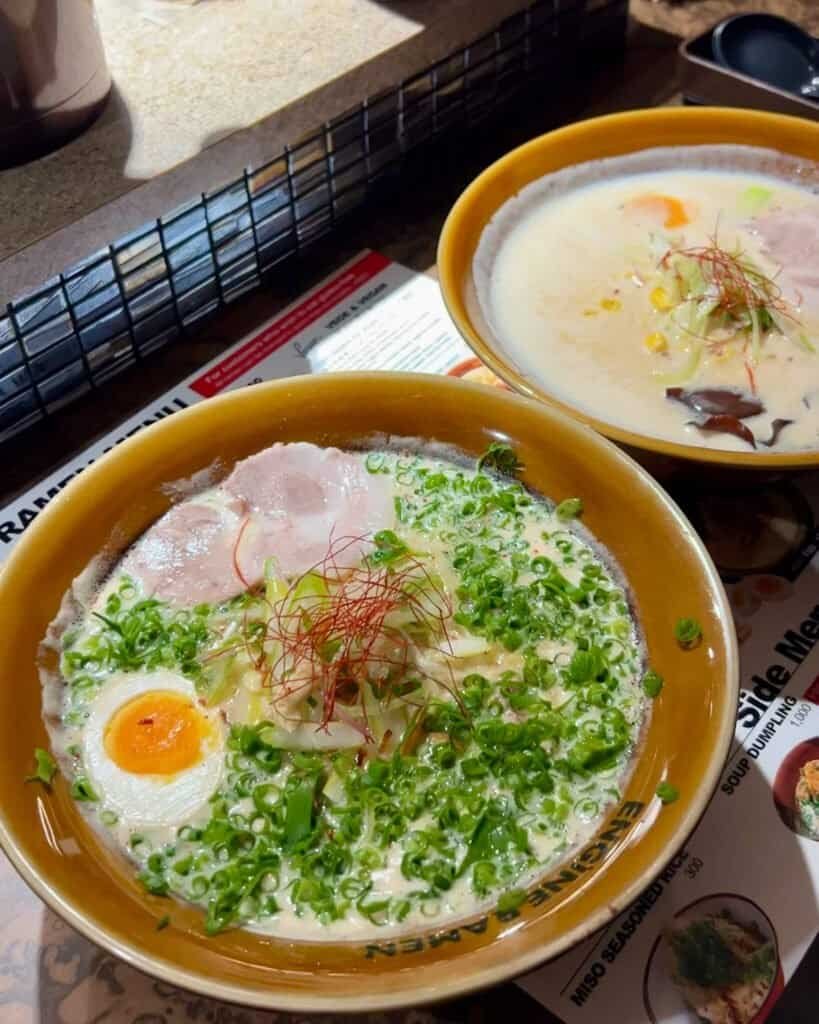
2D Tearoom BAW
2D Tearoom BAW is located in Nishiki Market, and I found it by accident. I was walking around in Nishiki Market, and luckily, I looked up when I saw a sign for a 2D Tearoom.
It felt like they might not have been open for long. I was also the only one inside, but the food was great! They focus on desserts, like waffles and ice cream in all kinds of flavours. The interior is all in 2D, which makes the entire experience extra fun.
I had a set menu with an oreo chocolate waffle with vanilla ice cream and coffee. Delicious! It’s the perfect place for dessert after trying out other great food at Nishiki Market.
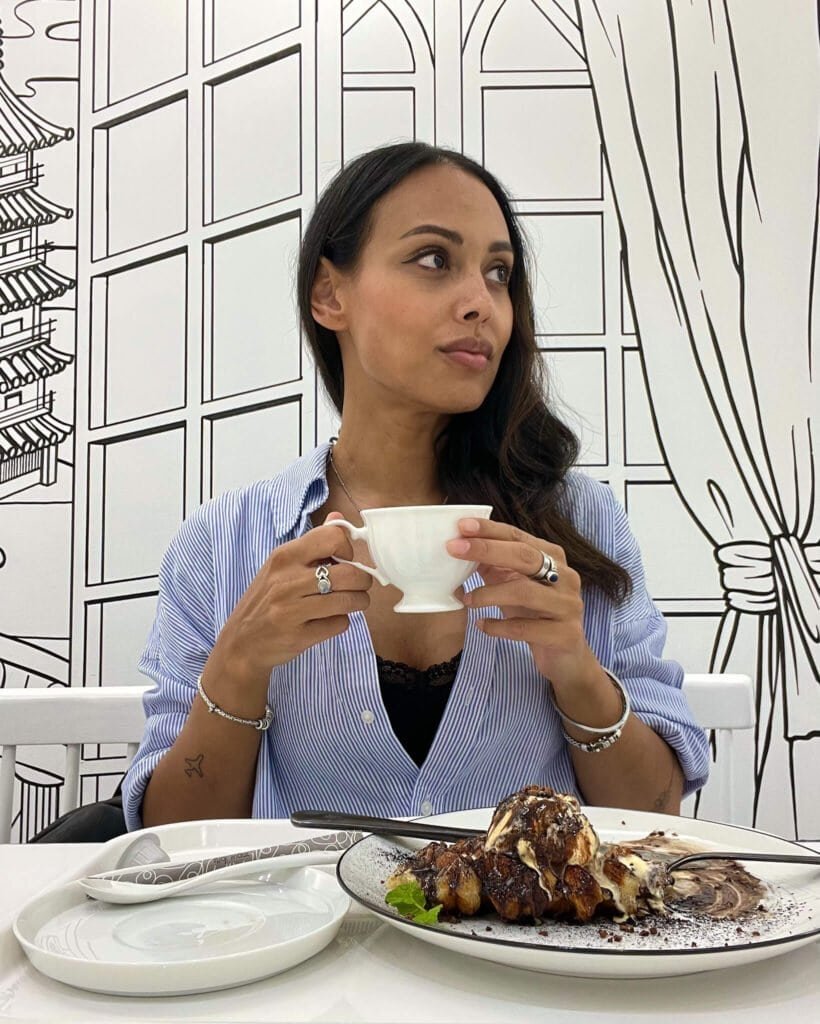
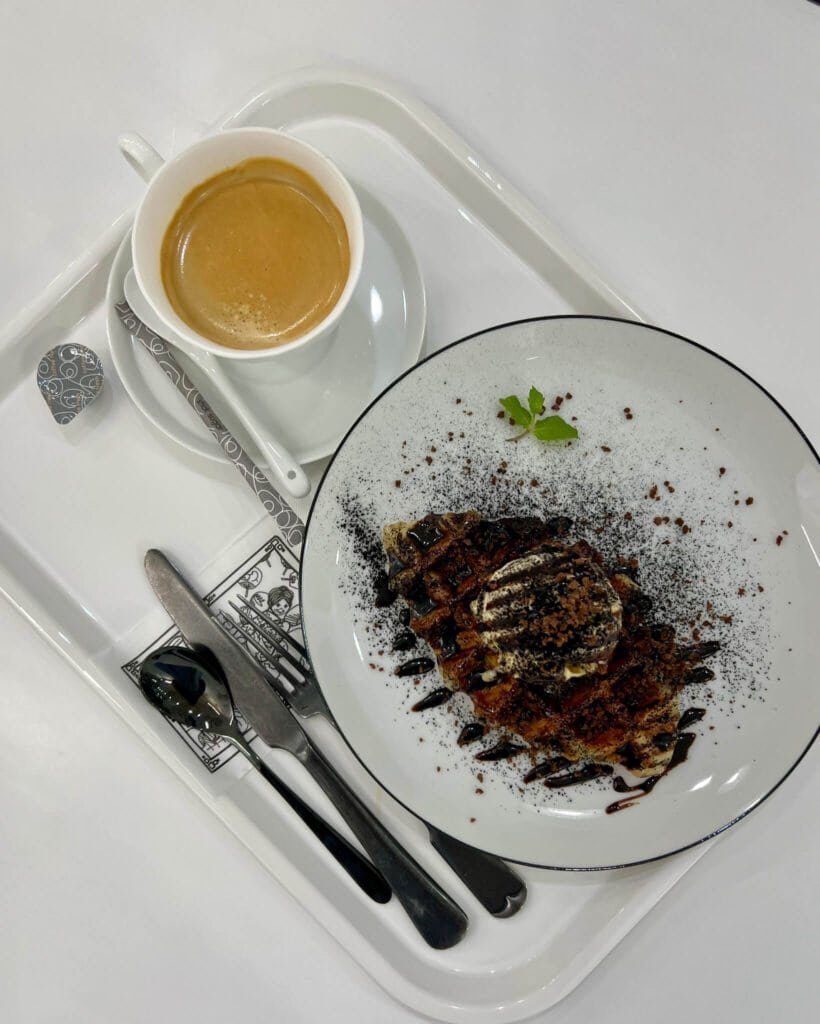
Things you need to know before visiting Kyoto
While I love Kyoto and feel it’s a must-visit in your Japan itinerary, there’s also a downside. Kyoto can get so crowded that it’s almost unbearable to visit tourist spots.
- Waking up early is the only way to avoid massive crowds. Pick which sights are the most important to you and visit them early in the morning. I also don’t linger when it’s too busy.
- Be prepared to walk a lot in Kyoto, so wear the most comfortable walking shoes. There is public transport, but there is still a lot of walking between sights or from the subway station.
- Don’t let others tell you not to visit the tourist sights just because they’re touristy. I’ve gotten comments on Instagram from people saying to skip the tourist sights. No. Visit what you want to visit, even if they’re touristy.
- Kyoto is a no-smoking city. Smoking on the streets is prohibited, and there are dedicated smoking areas in the city. If you’re a smoker, ask your hotel for a map to find these designated areas.
How to get around in Kyoto
The best way to get around Kyoto is on foot, by bike or by subway. Kyoto and Japan, in general, are very bikeable cities! Yes, there is public transport, and you can take buses and the subway. But the network is less extensive than Osaka and Kyoto, and I’ve noticed you still need to walk a fair bit from any subway station.
Especially near most tourist sights like Kiyomizu-dera or Gion, you might still need to walk at least fifteen minutes. A bike is a great, fast way to explore the city at a more relaxed pace than on foot. Just pay attention to where you can park your bike.
Take a day trip from Kyoto to Nara
Nara is an excellent day trip to visit from Kyoto, and if I remember correctly,y it’s only 20 minutes by train. In Nara, you’ll get to meet the famous bowing deer that walk around freely.
There is even a special train from Kyoto to Nara that looked like the Polar Express to me! Tickets are a bit more, and if you’re solo, you have to buy an adult and child ticket, since the seats are only sold in twos. It’s a supplement ticket on top of your regular ticket.
I have a full post on how to use public transport in Japan if you need more information!
I know this sounds confusing, but it will make sense when you see it. Don’t worry too much about it. There will be signs everywhere that you need a supplement ticket, which you can purchase on the platform.
This train happened to be the first train back from Nara to Kyoto for me, so I came across it by accident, but it was a fun experience.
The deer park is within walking distance from Nara Station, just follow the crowd. The park is free, and many stalls sell deer cookies.
Be careful, though! Deer are still wild animals, and even though they’re very adjusted to humans, they are unpredictable. I’ve seen people get bitten, kicked or attacked by deer.
So be mindful and don’t think they are some fluffy bunnies on a farm! Especially the male with giant antlers should be approached (or maybe not) with caution.
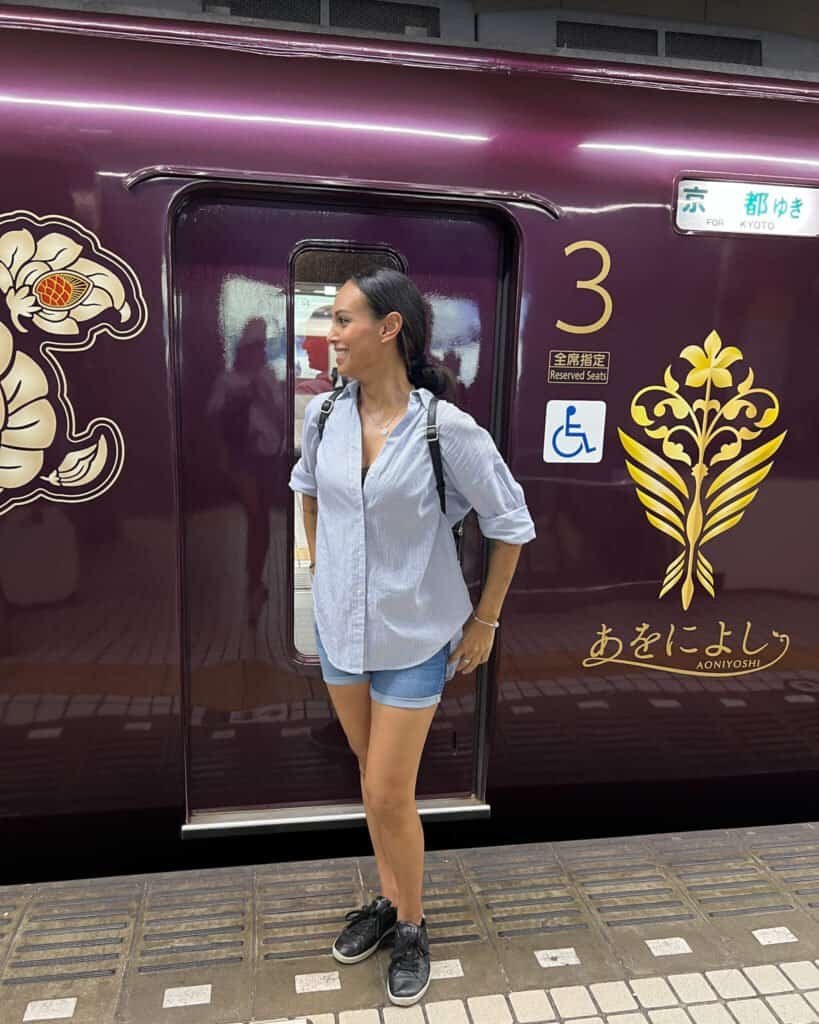
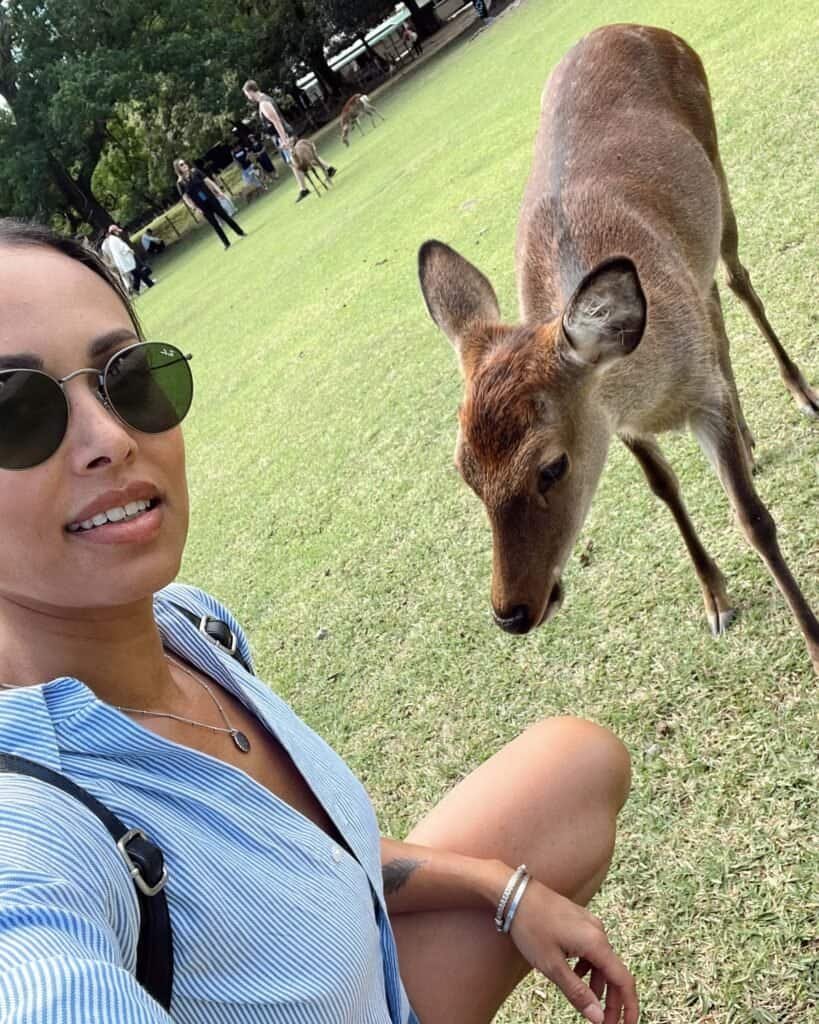
FAQ for your 2-day itinerary to Kyoto
Can I take a day trip to Osaka from Kyoto?
Yes! I met several travellers who used Kyoto as their base and took a day trip from Kyoto to Osaka.
How many days should I spend in Kyoto?
I would stay 3 full days for a more relaxed pace of sightseeing. However, you can see the highlights in 2 full days if you’re short on time.
Is Kyoto nicer than Tokyo?
Tokyo is a big, vibrant city with neon lights, technology and modernity. Kyoto is smaller, traditional and more authentic. I feel they’re opposites, so it’s hard to compare.
Is Kyoto walkable?
Yes, but wear comfortable shoes! You’ll be walking a lot in Kyoto, and it’s nice to explore the city on foot.
Plan your trip
With my online resources
Use my travel planning roadmap with all my digital resources to book every detail of your trip!
Kyoto is amazing if you look past the crowds! Or, do what I do and follow my tips to avoid the crowds. If you’re a foodie, do research beforehand on where to eat. There are so many great places, and being prepared will save you so much time.
This 2-day itinerary to Kyoto will be a great base plan when you have limited time in the city. Oh, and did you know you can have your luggage delivered from hotel to hotel? Check out travelling hands-free in Kyoto!
Please reach out if you have any questions! The fastest way is to leave a comment on my latest Instagram post or in the comments below!




